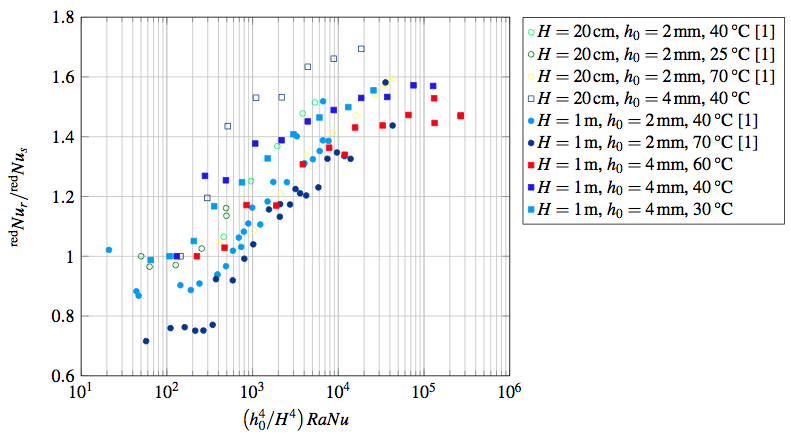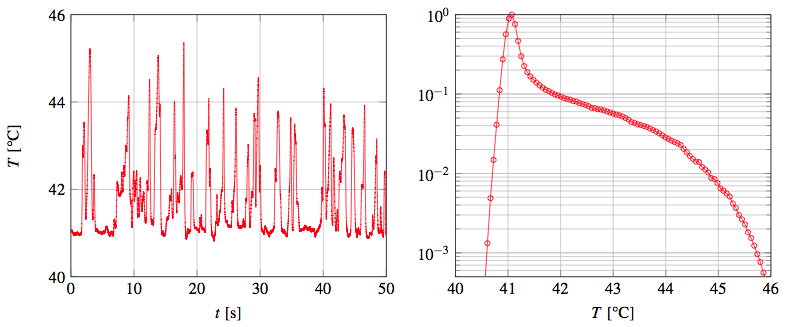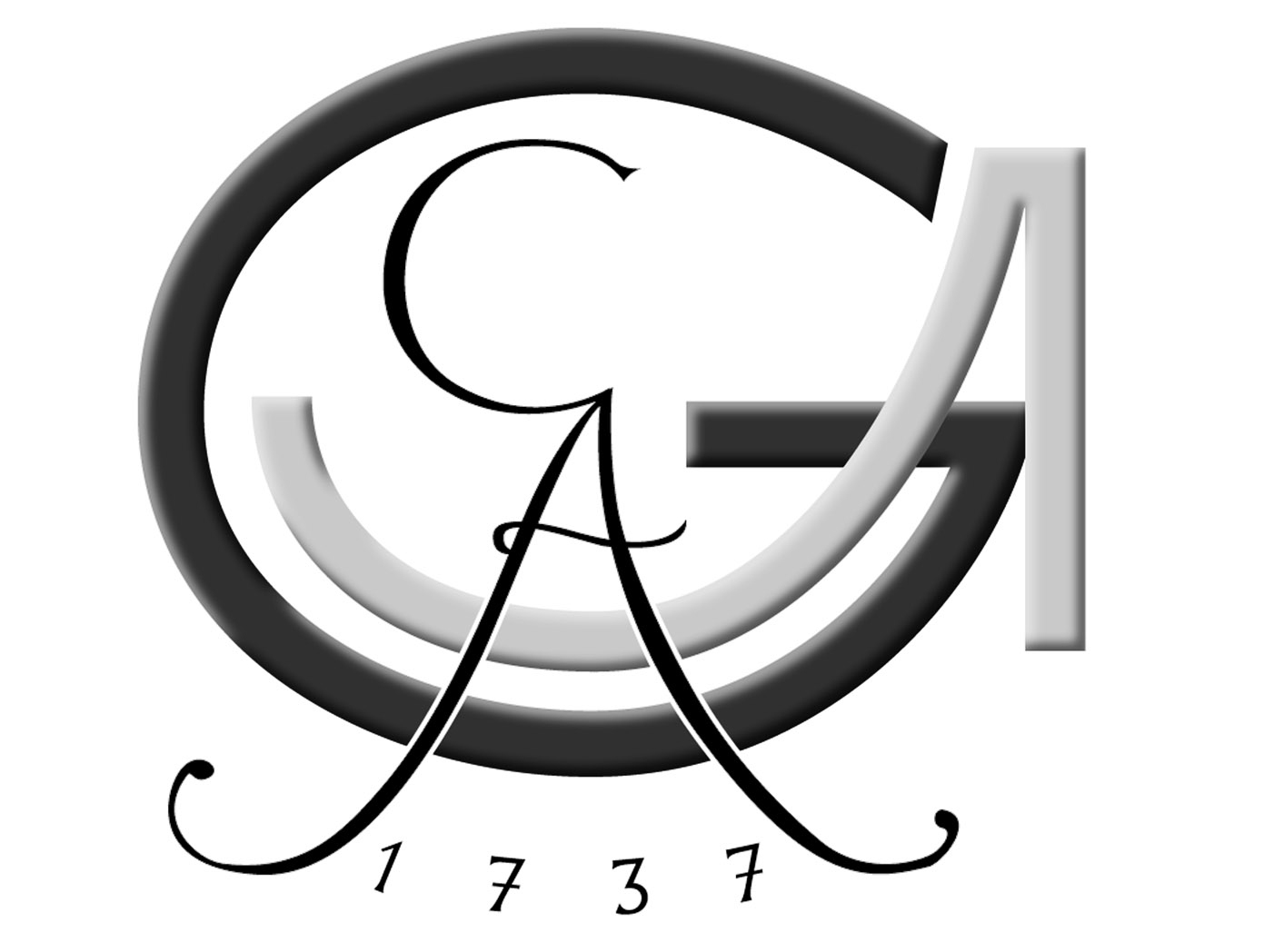Roughness-enhanced heat-flux in turbulent thermal convection
Turbulent thermal convection is an ubiquitous phenomenon in nature (atmosphere, ocean) and in industrial systems (heat exchanger, ventilation in buildings). To study this phenomenon, model systems can be used. One of the most extensively studied is the Rayleigh-Bénard cell. It consists in a fluid layer between two horizontal plates, heated from below and cooled from above. When the thermal forcing is strong, the flow induced by the temperature difference becomes highly turbulent. In this limit, the dynamics of the system is controlled by the thermal boundary layers where most of the temperature difference is located. For moderate thermal forcing with smooth plates, all experimental heat-flux measurements are consistent and relatively well understood.
For larger thermal forcing, the experimental heat-fluxes seem to highly depend on the details of the cell geometry and on the precise boundary conditions. To figure out how the boundary conditions act on the system, new experiments, in which a controlled roughness has been added, have been run recently in Lyon[1] and Hong Kong[2][3]. They exhibit new heat-transfer regimes in which the heat-flux is enhanced. But the mechanisms are not well understood and there are quantitative variations between experiments that lack an interpretation.
To go beyond those discrepancies and find a model, we have been carrying out systematic measurements with various square-stud roughness in two cylindrical cells (height H = 1 m and H = 20 cm and diameter D = 50 cm). Those cells are asymmetric: the hot plate is rough and the cold plate smooth. The independence of both plates, which is experimentally verified, then allows in situ comparison of the heat-transfer regimes of the rough and the smooth cases.
The new roughness have the same proportions as the ones previously used[1], with dimensions twice larger (the new height is h0 = 4 mm versus h0 = 2 mm in the previous setup). Our aim is to compare the results obtained in those setups. The little roughness show a transition for the heat-transfer of the rough plate, whereas no transition appears with the smooth one. The transition occurs when the height of the thermal boundary layer reaches the height of the roughness. This transition is independent of the aspect ratio of the cell.

Figure 1: Heat-transfer enhancement versus dimensionless power normalized by h0.
In these units, the transition threshold to the enhanced regime fairly collapses.
The large roughness cells show a saturation plateau at high thermal forcing for the rough plates. But, again, there is no transition on the smooth plate. The plateau seems to be independent of the aspect ratio. The comparison between those two sizes of roughness seems to reveal the existence of a characteristic length which is the height of the roughness. However, this length does not seem to be enough to fully collapse all data. It seems likely that the horizontal length scales may also play a role.
The common point of all the measurements is an enhancement of the thermal heat-transfer more than what is expected by the surface increase. In the large roughness case the heat-transfer enhancement reach 70%, with only 40% of surface increase (see figure 1).
Structure of the thermal boundary layers close to roughness
At high Rayleigh numbers, the flow structure is strongly influenced by the boundary conditions. Slight modifications in the boundary layers can dramatically increase the heat transfer efficiency. To figure out the enhancement mechanisms, we use another asymmetric Rayleigh-Bénard cell, with transparent walls, smooth top plate and controlled roughness on the bottom plate. The cell is a 10 cm-thick 40 cm x 40 cm rectangular cell with PMMA walls, filled with deionized water. The roughness are evenly spaced 2 mm-high 5 mm x 5 mm square plots, machined in the bulk of the copper plate.
To go beyond the global heat-flux discrepencies, we turned to local features of the flow. We use a miniature thermistor (400 µm diameter), located on the central vertical axis. In particular, we investigate the amplification mechanism: does it originate from a buoyancy instability inside the notches or from changes in the boundary layer structures? This analysis is carried out through the measurement of the local temperature at several locations near the roughness: above a roughness, inside a notch or along the groove, compared to the temperature statistics on the smooth plate.

Figure 2: Temperature signal and temperature histograms recorded
3 mm above a plot. The Rayleigh number is
Ra=5e10. The shape of the histogram is typical of a
position close but above the boundary layer.
The boundary layer thickness in our system is very thin, less than 500 µm. It is therefore not possible to measure profiles nor to directly measure its thickness. One alternative is to use the evolution of the shape of the local temperature histograms[4]. One example is shown in figure 2. This shows that the boundary layer is much thinner on top of a plot than it is on the smooth plate. One possible explanation is that the boundary layer does not have enough length to develop on the plots. This could lead to a smaller temperature impedance.
The analysis of the local measurements evidence a first enhancement mechanism: the boundary layer on the top of the roughness is washed by the flow and exhibit features of a turbulent boundary layer. We propose a model based on this observation to predict the heat transfer enhancement, and we compare it with heat transfer measurements.
The analysis of the fluctuations of the heat transfer efficiency of the rough plate reveals that the flow is bistable: one state shows a further increased heat transfer efficiency. The difference between the two regimes are investigated with visualization techniques. We show that the high-efficiency state is triggered by intermittent emission of coherent plumes.
To go further, we have carried out experiments in a much larger cell, the Barrel of Ilmenau, which allows direct visualisation of the velocity inside the boundary layer. The transnational access to the facility in Ilmenau is funded by the European Union (EuHIT project). More information on our preliminary results is available in a dedicated page.
Natural ventilation in buildings
In the energy resources and environmental context, one of the challenges is to reduce the energy consumption of buildings while maintaining comfort and especially during summer. Passive solutions based on night cross-ventilation combined with thermal mass of walls are promising solutions to match comfort criteria without any active system. There is currently a lack of publications giving empirical laws usable by designers, and most of the publications related to ventilation deal with indoor air quality. Few of them address the problem of summer comfort. So there is a clear need of better knowledge on this subject particularly on the modelling of real data.
A recent review on the efficiency of the natural ventilation in buildings[5] describes the various methods used to predict the air flow and heat exchange in buildings: analytical and empirical models, numerical models, etc. In particular, numerical simulations are widely used, and there is a lot of effort to improve them. They are efficient to predict mean values. However, there are only few available data to allow prediction of fluctuating quantities or the full dynamics of the flow.
In collaboration with Hervé Pabiou and Christophe Ménézo from CETHIL/INSA Lyon, supported by the iMust Labex, we are studying a small-scale experiment in a wind tunnel to obtain a database on ventilation in different configurations. The dependence of the flow rate on several parameters, like geometry, wind speed and wind direction, is studied. The aim is to characterize the mean value of the air flow or local air velocity but also their fluctuations. Indeed, to match comfort criteria, indoor air velocity must remain below a given threshold.
PETG small-scale model of a Lyon-Confluence duplex apartment (1/20 scale) used for measurements in ENS Lyon
wind tunnel.
To go further and to analyze the ability of ventilation to cool the walls of the experiment, the measurement techniques face a new a challenge. The question is to know if the bottleneck is in the heat transfer from the wall to the cold air or in the turbulent air transport itself. The scientific point is to measure turbulent heat flux in an air flow. To do this we are designing a new sensor for measuring local convective heat flux. More details on this sensor can be found in the Instrumentation section.
References
- [1]
- J.-C. Tisserand, M. Creyssels, Y. Gasteuil, H. Pabiou, M. Gibert, B. Castaing and F. Chillà. “Comparison between rough and smooth plates within the same Rayleigh-Bénard cell”, Phys. Fluids, 23:015105, 2011
- [2]
- Y.-B. Du and P. Tong. “Turbulent thermal convection in a cell with ordered rough boundaries”, J. Fluid Mech., 407:57-84, 2000
- [3]
- X.-L. Qiu, K.-Q. Xia and P. Tong. “Experimental study of velocity boundary layer near a rough conducting surface in turbulent natural convection”, Journal of Turbulence, 6(30):1, 2005
- [4]
- A. Belmonte, A. Tilgner and A. Libchaber. “Temperature and velocity boundary layers in turbulent convection”, Phys. Rev. E, 50(1):269-279, 1994
- [5]
- Q. Chen. “Ventilation performance prediction for buildings: A method overview and recent applications”, Building and Environment, 44:848-858, 2009



